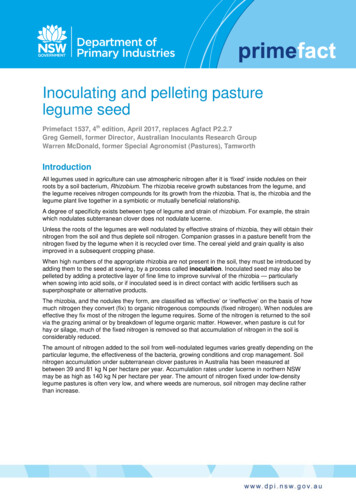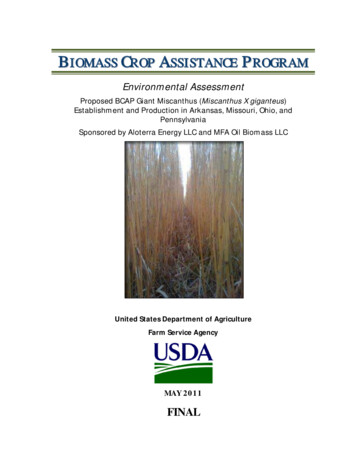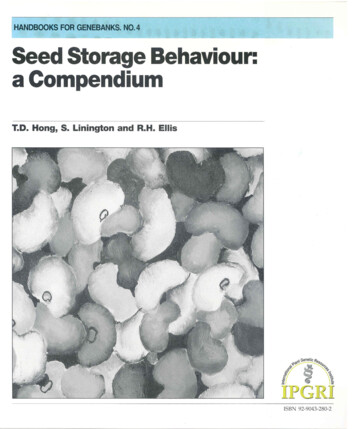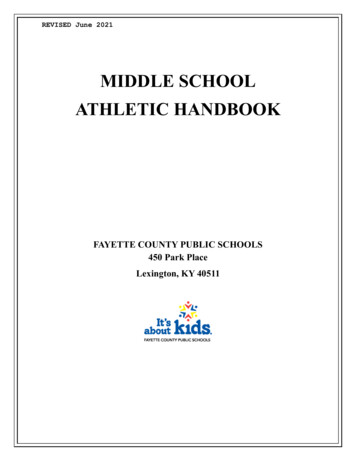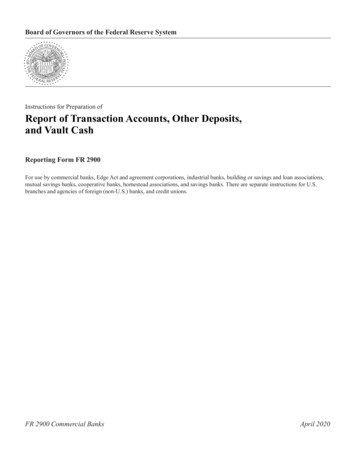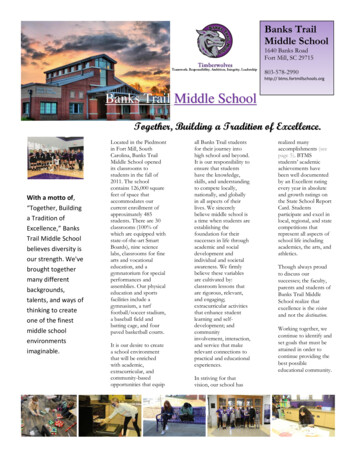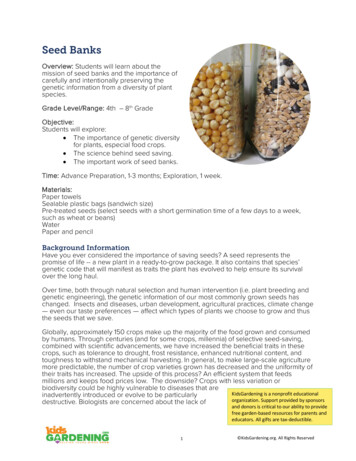
Transcription
Seed BanksOverview: Students will learn about themission of seed banks and the importance ofcarefully and intentionally preserving thegenetic information from a diversity of plantspecies.Grade Level/Range: 4th – 8th GradeObjective:Students will explore: The importance of genetic diversityfor plants, especial food crops. The science behind seed saving. The important work of seed banks.Time: Advance Preparation, 1-3 months; Exploration, 1 week.Materials:Paper towelsSealable plastic bags (sandwich size)Pre-treated seeds (select seeds with a short germination time of a few days to a week,such as wheat or beans)WaterPaper and pencilBackground InformationHave you ever considered the importance of saving seeds? A seed represents thepromise of life -- a new plant in a ready-to-grow package. It also contains that species’genetic code that will manifest as traits the plant has evolved to help ensure its survivalover the long haul.Over time, both through natural selection and human intervention (i.e. plant breeding andgenetic engineering), the genetic information of our most commonly grown seeds haschanged. Insects and diseases, urban development, agricultural practices, climate change— even our taste preferences — affect which types of plants we choose to grow and thusthe seeds that we save.Globally, approximately 150 crops make up the majority of the food grown and consumedby humans. Through centuries (and for some crops, millennia) of selective seed-saving,combined with scientific advancements, we have increased the beneficial traits in thesecrops, such as tolerance to drought, frost resistance, enhanced nutritional content, andtoughness to withstand mechanical harvesting. In general, to make large-scale agriculturemore predictable, the number of crop varieties grown has decreased and the uniformity oftheir traits has increased. The upside of this process? An efficient system that feedsmillions and keeps food prices low. The downside? Crops with less variation orbiodiversity could be highly vulnerable to diseases that areKidsGardening is a nonprofit educationalinadvertently introduced or evolve to be particularlyorganization. Support provided by sponsorsdestructive. Biologists are concerned about the lack ofand donors is critical to our ability to providefree garden- ‐based resources for parents andeducators. All gifts are tax- ‐deductible.1 KidsGardening.org. All Rights Reserved
genetic resources within these crops that would allow them to breed varieties that canwithstand such diseases.Already three-quarters of the biodiversity in crops have been lost in the last century,according to the Food and Agriculture Organization. Biodiversity is the degree of variationwithin a given ecosystem or biome. It is often an indicator of the health of the ecosystembecause greater biodiversity implies greater health. Biodiversity can also refer to thegenetic variations among plants within a species, such as a particular crop.Saving a wide variety of seeds (not just the ones most commonly grown) can increase ourability to overcome diseases and environmental challenges in the future. Making sure thatthere is a diversity of genetic information available so scientists can find plants with theright traits at the right time is critical. Keeping seeds viable (able to grow) over time is nosmall job. Specialized seed banks or gene banks are designed to provide the idealstorage conditions to guarantee the safekeeping of this valuable genetic material.Seed banks serve as an insurance policy for the future of agriculture and plant science.Disasters, such as war, hurricanes, and other destructive events, will happen and whenthey do, entire crops of food and fiber may be eliminated. If seed banks aren’t available tohelp provide new seeds and plants for these locations, human populations may suffer fromdevastating conditions, including famines and economic collapse.The purpose of a seed bank is to: Conserve the diversity of plant species. Offer resources for breeding of stronger crop varieties. Provide food solutions in times of disaster. Safeguard food supplies for future generations.How They WorkIn a seed bank, seeds are kept in a cool (generally frozen), dry condition so that they donot sprout or rot. Periodically, the seeds are used to grow new plants, which will in turnproduce fresh seeds for the seed bank. This rotational system keeps the seed viable overtime since most seed cannot be kept indefinitely.Seed banks may contain more than just seeds. Some plants require even moresophisticated methods of gene-banking as they are most commonly grown from tubers,rhizomes, cuttings, and tissue culture. For example, crops such as potatoes, yams, andcassava are grown from tubers or rhizomes. They do not produce true seed, for when theydo, they shuffle their genes so that the potatoes or yams that grow from the seed are notgenetically identical to the plants that produced them. The particular qualities of thatvariety are lost unless the tubers themselves are stored. They are easily stored for a shorttime, but must be regenerated (replanted) much more often than most seeds.Other plants pose even greater difficulties. Many cultivated bananas and plantainsproduce no seed at all — they are sterile, and they don’t produce any storage organs(tubers or rhizomes) either. They are propagated exclusively by cuttings. Seed banks usenew technology to store the cells of these plants by growing them on a gel and feedingthem nutrients and hormones to grow entirely new plants.KidsGardening is a nonprofit educationalThey also store these cells through a special form oforganization. Support provided by sponsorsfreezing called cryopreservation (-196 C).and donors is critical to our ability to providefree garden- ‐based resources for parents andeducators. All gifts are tax- ‐deductible.2 KidsGardening.org. All Rights Reserved
In their Genebank Standards Guide, the Food and Agriculture Organization (FAO) lists thatthere are about 1,750 individual seed banks worldwide. One of the largest and mostimportant seed banks is the Global Seed Vault near Longyearbyen, Norway. TheNorwegian island of Svalbard houses this vault, built in 2008. The vault sits halfway up amountain overlooking the main airport and fjord near the island’s capital. Descendingalmost 500’ under the permafrost, the entrance tunnel to the seed vault is designed towithstand bomb blasts and earthquakes. An automated digital monitoring system controlstemperature and provides security akin to Fort Knox. No one person has all the codes forentrance. Although there are many seed banks, few are as high-tech or secure as theGlobal Seed Vault. The security of the vault is important for all nations because it nowcontains samples from one-third of the world’s most important food crop varieties.The seed vault functions like a safe deposit box in a bank. Like a bank owning thebuilding, the Government of Norway owns the vault and other seed banks make depositswith the seeds they send. The seed samples that are stored in the vault are copies ofsamples stored in other banks. The vault is simply a way to keep specific samples safeand secure. No one has access to anyone else’s seeds inside the seed vault. There aremany organizations that help operate the vault. They care for the seeds, coordinateshipments, and record valuable information.The Global Vault is part of a broad effort to gather and record information about plants andtheir genes. A system of plant banks could be crucial in responding to climate crisis sinceit could identify genetic material and plant strains better able to cope with a changedenvironment.Laying the Groundwork:Begin your discussion of the importance of saving seeds by providing an example of whenwhat can happen when there is a lack of diversity in plant species. The Irish PotatoFamine of the 1800s provides a prime example.Potatoes are generally not grown from seed, but rather from “starts” or "eyes” in the tuberitself. (The small potato pieces commonly planted are sometimes referred to as “seedpotatoes”. These starts are genetically identical to the parent plant. During the late 17thcentury, the potato became the widespread dietary staple in Ireland. Many people werepoor and had small farms. They relied on the potato because it grew in the relatively coolclimate and provided sufficient calories to sustain the population. Because few, if any,potatoes were grown from seed in this region, the plants had very little variation. Thisgenetic uniformity left the potatoes — and the people that depended upon them forsustenance, — vulnerable to a pest or disease outbreak because each plant was equallysusceptible.It is unclear where the fungus that caused the potato blight originated — perhaps on a shipfrom Baltimore or New York — but in 1845, a rot disease caused by Phytophthora infestanshit Ireland, turning non-resistant potatoes into inedible slime. In just a few months it spreadthroughout Ireland, destroying more than one-third of the potato crop. By the followingyear (and for the next seven years), three-quarters of the crop was lost to potato blight.Little seed had been saved because few felt that it was necessary when the plant couldbe grown from the tuber. Because Ireland was so dependent on the potato as the majorsource of calories and nutrients, especially among the poor, KidsGardening is a nonprofit educationalthe Great Famine, as it came to be known, resulted in anorganization. Support provided by sponsorsestimated one million deaths from starvation. It alsoand donors is critical to our ability to providefree garden- ‐based resources for parents andeducators. All gifts are tax- ‐deductible.3 KidsGardening.org. All Rights Reserved
resulted in a mass exodus as millions of residents relocated to other countries (many tothe United States) as a means of survival.Today, we understand that relying on crops with low genetic variation can lead to disaster.The Great Famine had a number of causes, but the disaster would not likely have been sosevere if either the potatoes had more genetic diversity or more seed were available tostrengthen the variety available. Some potatoes would have carried the right genes tosurvive infection by the fungus, and more of the resistant varieties could have beenplanted in the years following the first epidemic.Introduce seed banks to your students and explain how they can play a critical role infinding these types of solutions. As a class, ask students to list some of the most importantcrops in our food system. You will likely be surprised how just a few, like corn, wheat, andrice, make up the bulk of our diet. Discuss the potential for the changes in their diet thatwould occur if wheat, rice, or corn could no longer be grown in the United States. Wouldthere also be global repercussions from such an event? Tell the students that there areover 100,000 varieties of rice and its relatives stored in seed banks. Why would this be animportant fact to the global community?Advance Preparation:For the Exploration section of this lesson, students will test germination rates of seeds thathad previous been saved in cold storage. Choose seeds with short germination times,such as wheat or beans. To prepare, place a class set of seeds in the freezer threemonths before the Exploration. Place another set in the freezer two months before theExploration and a third set one month before the Exploration.Exploration:1. Ask the students to describe the purpose of a vault or safe. What kinds of things belongin a vault or a safe? Explain to the students the importance of keeping seeds safe. Askthem to brainstorm ways that seeds could be saved. In the short-term, seeds can be keptin dry, cool locations and need to be protected from rodents and other insects that may tryto eat them. Use the Background Information to explain some of the complexities involvedwith long-term storage.2. Explain to students that you have pre-treated a selection of seeds and that you plan totest to see if the treatment has impacted germination rates.3. Divide students into at least four teams, with each team trying to germinate seeds thatexperienced a different pre-treatment, (If you pre-treated more than one type of seed thenyou may need more teams.) Team 1 will try to germinate seeds that were in the freezer forthree months. Team 2 will try to germinate seeds that were in the freezer for two months.Team 3 will try to germinate seeds that were in the freezer for one month. And Team 4 willtry to germinate seeds that were never placed in a freezer. Have teams place the seedson wet paper towels in sealed plastic bags and keep them at room temperature.4. Have students carefully observe the seeds every day and track the number of seedsthat have germinated. At the end of one week, have them calculate the germination rateof the seeds: Divide the number of seeds that germinatedby the total number of seeds and multiply by 100.KidsGardening is a nonprofit educationalorganization. Support provided by sponsorsand donors is critical to our ability to providefree garden- ‐based resources for parents andeducators. All gifts are tax- ‐deductible.4 KidsGardening.org. All Rights Reserved
Example: If 15 out of 20 seeds germinated: 15 divided by 20 equals .75, multiplied times100 75. So the germination rate was 75%.5. Ask, did cold storage have an impact on our seeds? What do you think would havehappened if they had been left in cold storage longer?Making Connections:Use this video from The Crop Trust to further explain the importance of crop diversity andto introduce the Global Seed Vault: https://www.youtube.com/watch?v UGAMn4LALls.Locate the Svalbard Islands on a map. Why was this location chosen? Unfortunately, eventhis site is not immune to disaster. In 2017, the Vault experienced flooding due to Arctic icemeltingAsk students to consider what this might mean for our society. What are some othersolutions available to us to help preserve diversity? Ask them, how can we use our homeand school gardens to help?ExtensionAs a class, determine a few plants from your garden that you could save seeds from. Listthe steps and form a plan for harvesting, preparing, and preserving those seeds. Discussthe advantages and disadvantages of saving seeds from year to year.Check out the Seed Savers Exchange (https://www.seedsavers.org/), a nonprofit whomission is to help preserve diversity in our food crops. Schools are eligible to apply forcommunity seed donations at: n addition to seed banks, many botanical gardens and arboreta are working to preserveplant species. There are also substantial rare plant and seed collections in botanicalgardens around the world. It is estimated that botanical gardens grow over 80,000 plantspecies (approximately one-third of all known plant species). If possible, schedule a classtrip to a local botanical garden to learn more about their collections.KidsGardening is a nonprofit educationalorganization. Support provided by sponsorsand donors is critical to our ability to providefree garden- ‐based resources for parents andeducators. All gifts are tax- ‐deductible.5 KidsGardening.org. All Rights Reserved
there are about 1,750 individual seed banks worldwide. One of the largest and most important seed banks is the Global Seed Vault near Longyearbyen, Norway. The Norwegian island of Svalbard houses this vault, built in 2008. The vault sits halfway up a mountain overlooking the main airport and fjord near the island's capital. Descending


